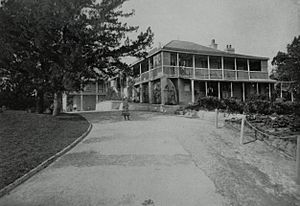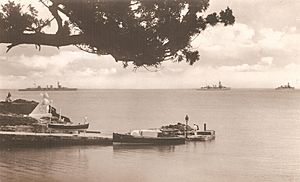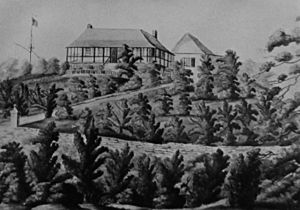Admiralty House, Bermuda facts for kids
Quick facts for kids Admiralty House, Bermuda |
|
|---|---|

Admiralty House at Clarence Hill, formerly St. John's Hill
|
|
| Active | 1795-1956 |
| Country | |
| Branch | |
| Role | Station command |
| Garrison/HQ | North America and West Indies Station |
Admiralty House, Bermuda was a very important building. It was the official home and office for the top officer of the Royal Navy (the British Navy) in Bermuda. Bermuda was a British colony, like a military base, back then. The officer in charge was called the Commander-in-Chief of the North America and West Indies Station.
Contents
Where Was Admiralty House First?
The very first Admiralty House was at Rose Hill. This was in St. George's Town. It was used from 1795 to 1806. A famous Irish poet, Thomas Moore, even worked there in 1803.
At that time, St. George's Harbour was the only safe place for big navy ships. It had a known path through Bermuda's coral reefs. The Royal Navy wanted to build a big base. They planned to put it at the other end of Bermuda.
Navy experts spent many years mapping the reefs. They found a new channel for ships. This channel led to Murray's Anchorage. This opened up the West End of Bermuda for large ships.
In 1810, the Admiralty rented St. John's Hill. This property was at Spanish Point. It became the home for the Royal Navy's Commander-in-Chief. Later that year, Admiralty House moved to Mount Wyndham. This spot was above Bailey's Bay. From here, they could see both St. George's Harbour and Murray's Anchorage. They could send signals between these places.
In 1812, St. John's Hill became a naval hospital. This happened during a yellow fever outbreak.
Moving to the West End

The Royal Navy was building a big base. This was the Royal Naval Dockyard. It was located at Ireland Island, Bermuda. Mount Wyndham was too far away to see this new base. So, in 1813, the Admiralty rented Spanish Point again.
During the American War of 1812, important plans were made at Mount Wyndham. These plans included blocking American ports. They also planned a raid on Chesapeake Bay in 1814. This raid included burning Washington D.C.
In 1816, the Government of Bermuda bought St. John's Hill. They gave it to the Admiralty. "Admiralty House" moved there from Mount Wyndham that same year.
The End of Admiralty House
In 1822, St. John's Hill was renamed "Clarence Hill". This was to honor Prince William. He later became King William IV. Clarence Hill remained Admiralty House until 1956. That's when it finally closed.
What Happened After?
After 1956, the building was used for different things. For a while, it housed a part of the Bermuda Regiment. Then, the Bermuda Police Service used it as a place for police officers to live.
Sadly, the old Admiralty House building became unsafe. It was too expensive to fix. So, it was purposely burned down on January 24, 1974.
Later, there were plans to build a college campus there. This would have included a hotel training school. But local groups protested this idea. They wanted the area to remain a park. The protests worked! The hotel school was built somewhere else.
What's There Now?
Today, most of the land is a public park. But part of the Clarence Hill property is still used by the navy. Since 1968, it has been home to TS Bermuda. This is the main unit for the Bermuda Sea Cadet Corps. The Sea Cadets are a youth organization. They teach young people about naval traditions and skills.
Mount Wyndham, the second Admiralty House, became a private home again. Now, it's part of a group of houses. Rose Hill, the very first Admiralty House, is now a hotel and time-share resort. The original buildings are no longer there.



